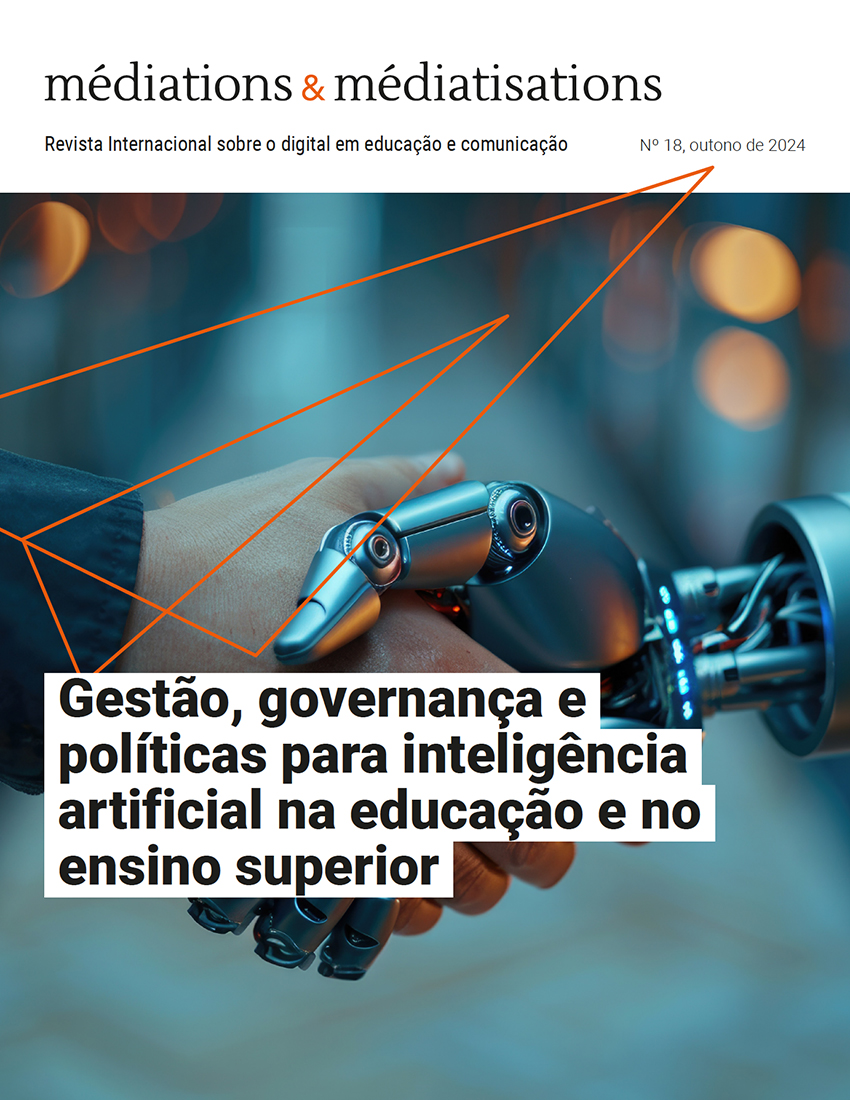ChatGPT: que utilização espontânea lhe deram os estudantes do primeiro ano da universidade quando chegou?
##plugins.themes.bootstrap3.article.main##
Resumo
A utilização de plataformas de inteligência artificial, e do ChatGPT-3 em particular, tem vindo a levantar questões no mundo académico desde dezembro de 2022. Alguns professores estão assustados, enquanto outros vêem muitas oportunidades para si e para os seus alunos. Mas que uso é que os alunos fazem realmente desta IA? Esta investigação centra-se na utilização do ChatGPT-3 pelos alunos do primeiro ano da Universidade de Namur (Bélgica). O inquérito foi realizado em fevereiro e março de 2023, alguns meses após o lançamento do ChatGPT-3. Estudantes de seis faculdades (informática, direito, medicina, ciências, economia, ciências sociais e gestão, bem como filosofia e literatura) foram inquiridos para saber mais sobre a sua utilização do ChatGPT, bem como para identificar os cursos em que o utilizam. O inquérito também destacou os benefícios percebidos pelos estudantes na utilização do ChatGPT-3 e na utilização da inteligência artificial em geral. Estes dados são interpretados de acordo com o modelo de estratégias de aprendizagem desenvolvido por Boulet et al. (1996). Por fim, mostramos como os dados recolhidos abrem novas vias de investigação sobre o pensamento crítico dos alunos quando utilizam o ChatGPT.
Downloads
##plugins.themes.bootstrap3.article.details##

Este trabalho encontra-se publicado com a Licença Internacional Creative Commons Atribuição-NãoComercial-CompartilhaIgual 4.0.
Referências
Anderson, L.W., et Krathwohl, D.R. (dir.) (2001). A taxonomy for Learning, teaching, and assessing: A revision of Bloom’s taxonomy of educational objectives. New York : Addison Wesley Longman.
Atlas, S. (2023). ChatGPT for Higher Education and Professional Development: A Guide to Conversational AI. https://digitalcommons.uri.edu/cba_facpubs/548
Baidoo-Anu, D., Owusu Ansah, L. (2023). Education in the Era of Generative Artificial Intelligence (AI): Understanding the Potential Benefits of ChatGPT in Promoting Teaching and Learning. Journal of AI. 7(1), 52-62.
https://doi.org/10.61969/jai.1337500 DOI: https://doi.org/10.61969/jai.1337500
Bloom, B.S. (dir.), Engelhart, M.D., Furst, E.J., Hill, W.H., et Krathwohl, D.R. (1956). Taxonomy of educational objectives: The classification of educational goals. Handbook 1: Cognitive domain. New York : David McKay.
Bolukbasi, T., Chang, K-W., Zou, J. Y., Saligrama, V., Kalai, A. T. (2016). Man is to Computer Programmer as Woman is to Homemaker? Debiasing Word Embeddings, Advances in Neural Information Processing System, 29.
Boulet, A., Savoie-Zajc, L., Chevrier, J. (1996). Les stratégies d’apprentissage, Presses de l’Université du Québec.
DPG Media, (2022, 8 décembre). L'intelligence artificielle ChatGPT va-t-elle remplacer les enseignants, les auteurs et les journalistes? https://tinyurl.com/268xvr7v
Duboust, O. (2023, 8 février). Comment le monde de l’enseignement s’adapte à ChatGPT, Euronews. https://fr.euronews.com/next/2023/01/23/comment-le-monde-de-lenseignement-sadapte-a-chatgpt
Elkhodr, M., Gide, E., Wu, R., Darwish, O. (2023). ICT students’ perceptions towards ChatGPT: An experimental reflective lab analysis. STEM Education, 3(2), 70-88. https://doi.org/10.3934/steme.2023006 DOI: https://doi.org/10.3934/steme.2023006
Firat, M. (2023). What ChatGPT means for universities: Perceptions of scholars and students. Journal of Applied Learning & Teaching, 6(1). https://doi.org/10.37074/jalt.2023.6.1.22 DOI: https://doi.org/10.37074/jalt.2023.6.1.22
Floridi, L., Chiriatti, M. (2020). GPT-3: Its Nature, Scope, Limits, and Consequences. Minds and Machines, (30), 681-694. https://doi.org/10.1007/s11023-020-09548-1 DOI: https://doi.org/10.1007/s11023-020-09548-1
Fortier, M. (2023, 8 février). « Intelligence artificielle, malaise réel dans les cégeps ». Le Devoir. https://tinyurl.com/37ks5sf6
Hanum Siregar, F., Hasmayni, B., et Lubis, A. H. (2023). The Analysis of Chat GPT Usage Impact on Learning Motivation among Scout Students. International Journal of Research and Review, 10(7), 632‑638. https://doi.org/10.52403/ijrr.20230774 DOI: https://doi.org/10.52403/ijrr.20230774
Hong, W.C.H. (2023). The impact of ChatGPT on foreign language teaching and learning: opportunities in education and research. Journal of Educational Technology and Innovation. https://doi.org/10.61414/jeti.v5i1.103 DOI: https://doi.org/10.61414/jeti.v5i1.103
Lavassani, K. M., Movahedi, B. et Kumar, V. (2009). Developments in analysis of multiple response survey data in categorical data analysis: the case of enterprise system implementation in large North American firms. Journal of Applied Quantitative Methods, 4(1). http://jaqm.ro/issues/volume-4,issue-1/pdfs/lavassani_movahedi_kumar.pdf
Kasneci, E., Sessler, K., Kuchemann, S., Bannert, M., Dementieva, D., Fischer, F., Gasser, U., Groh, G., Günnemann, S., Hüllermeier, E., Krusche S., Kutyniok, G., Michaeli, T., Nerdel, C., Pfeffer, J., Poquet, O., Sailer, M., Schmidt, A., Seidel, T., Kasneci, G. (2023). ChatGPT for good? On opportunities and challenges of large language models for education. Learning and Individual Differences, 103, article 102274. https://doi.org/10.1016/j.lindif.2023.102274 DOI: https://doi.org/10.1016/j.lindif.2023.102274
Ngo, T. T. A. (2023). The Perception by University Students of the Use of ChatGPT in Education. International Journal of Emerging Technologies in Learning, 18(17), 4‑19. https://doi.org/10.3991/ijet.v18i17.39019 DOI: https://doi.org/10.3991/ijet.v18i17.39019
Saint-Pierre, L. (1991). L’étude et les stratégies d’apprentissage. Pédagogie collégiale, 5(2),15-21.
Valova, I., Mladenova, T., et Kanev, G. (2024). Students’ Perception of ChatGPT Usage in Education. International Journal of Advanced Computer Science and Applications, 15(1). https://doi.org/10.14569/IJACSA.2024.0150143 DOI: https://doi.org/10.14569/IJACSA.2024.0150143

